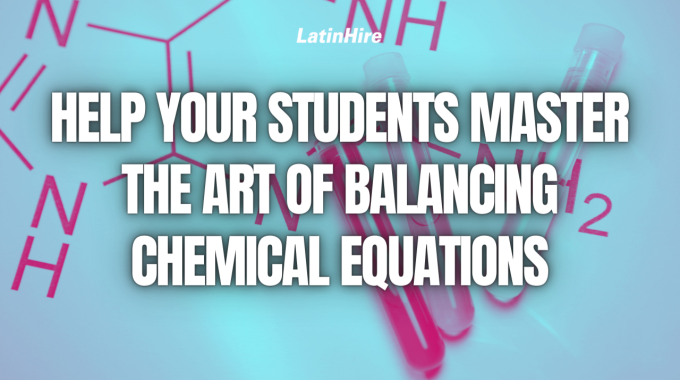Hydrocarbons form the backbone of organic chemistry, and understanding how to name and draw them…

Help Your Students Master the Art of Balancing Chemical Equations
Balancing chemical equations is a fundamental skill that allows students to understand chemical reactions at the atomic level. One of the most important concepts in chemistry is that matter cannot be created nor destroyed. This means that the atoms at the start of a reaction must be the same atoms at the end of a reaction. To satisfy this law of conservation of mass and matter, all chemical equations must be balanced.
Balancing chemical equations can be a daunting task for many students and also a challenge for teachers to teach. But fear not! This article will help you explore the ideas and some strategies and steps to help your students balance chemical equations more efficiently.
Understanding the Law of Conservation of Mass
The Law of Conservation of Mass states that the mass of reactants and the mass of products in a chemical reaction must be equal because matter cannot be created nor destroyed. During a chemical reaction, chemical bonds are broken and formed, but the same number and type of atoms must be present before and after the reaction.
It’s like using a LEGO set to build various structures. The structures may look different, but the pieces of LEGO are all the same, just connected in different ways. You can use this analogy to help your students better understand that breaking and forming of bonds between different atoms is like breaking the LEGO pieces apart and attaching them to other pieces.
When we take a LEGO structure apart and build a new one, we’re not creating or destroying LEGO pieces, only rearranging the existing pieces. Similarly, matter cannot be created nor destroyed in a chemical reaction, so when we write a chemical equation, the number of atoms on the reactant side must equal the number of atoms on the product side.
Steps to Balancing Chemical Equations

Let’s take the example of Copper + Silver Nitrate → Copper (II) Nitrate + Silver.
Step 1: Write the skeletal equation.
Cu + AgNO3 → Cu(NO3)2 + Ag
Step 2: Balance the metals first.
Copper (Cu) and silver (Ag) are the two metals in this equation, and they are both already balanced.
Step 3: Balance the polyatomic ions as one unit.
The nitrate ion (NO3−) is a polyatomic ion. On the reactant side, there is one nitrate ion, and on the product side, there are two. To balance this, add a coefficient of 2 in front of AgNO3 on the reactant side:
Cu + 2 AgNO3 → Cu(NO3)2 + Ag
Notice that as a result of adding a coefficient of 2 in front of AgNO3, there are now 2 silver (Ag) atoms on the reactant side and one silver atom on the product side. To balance these, add a coefficient of 2 in front of silver on the product side as well.
Cu + 2 AgNO3 → Cu(NO3)2 + 2 Ag
Step 4: Balance the non-metals (except for oxygen and hydrogen).
In this case, nitrogen is the only non-metal. The number of nitrogen atoms is already balanced since it’s part of the polyatomic ion.
Step 5: Balance the oxygens and hydrogens.
Counting the oxygen atoms, we see that they are already balanced with six on each side.
Step 6: Check your work and count the number of atoms on the reactant and product sides.
Always, at the end of a balancing equations exercise, you must check your work to ensure that the number of each type of atom is the same on both sides of the equation:
Reactant side: Cu + 2AgNO3
- Cu: 1 atom
- Ag: 2 atoms
- N: 2 atoms
- O: 6 atoms
Product side: Cu(NO3)2 + 2Ag
- Cu: 1 atom
- Ag: 2 atoms
- N: 2 atoms
- O: 6 atoms
The equation is now balanced!
Note: Use fractions when needed.

Let your students know that it’s okay to use fractions while balancing the chemical equation. If a coefficient doesn’t result in a whole number, leave it as a fraction. This is particularly helpful when dealing with equations involving odd or prime numbers. At the end, they can convert the fractions into whole numbers.
For example, balancing the combustion reaction: ethane + oxygen → carbon dioxide + water
Step 1: Write the skeletal equation.
C2H6 + O2 → CO2 + H2O
Step 2: Balance the metals first.
There are no metals in this equation.
Step 3: Balance the polyatomic ions as one unit.
There are no polyatomic ions in this equation.
Step 4: Balance the non-metals (except for oxygen and hydrogen).
The only non-metal in this equation is carbon (C). There are two carbon atoms on the reactant side and one carbon atom on the product side. Add a coefficient of 2 to CO2.
C2H6 + O2 → 2 CO2 + H2O
Step 5: Balance the oxygens and hydrogens.
Since oxygen (O) is on its own on the reactant side, balance that one last. By counting the hydrogen atoms (H), we see that there are six hydrogen atoms on the reactant side and two hydrogen atoms on the product side. Add a coefficient of 3 to H2O to balance out the hydrogens.
C2H6 + O2 → 2 CO2 + 3 H2O
Now, we can balance the oxygen atoms. There are two oxygen atoms on the reactant side and seven oxygen atoms on the product side. In this case, we can add a fraction coefficient of 7/2 in front of O2 which balances the entire equation.
C2H6 + 7/2 O2 → 2 CO2 + 3H2O
Since the final balanced equation cannot contain a fraction, multiply all the coefficients by 2 to get rid of the fraction.
2 C2H6 + 7 O2 → 4 CO2 + 6 H2O
Step 6: Check your work and count the number of atoms on the reactant and product sides.
Reactant side: 2 C2H6 + 7 O2
- C: 4 atoms
- H: 12 atoms
- O: 14 atoms
Product side: 4 CO2 + 6 H2O
- C: 4 atoms
- H: 12 atoms
- O: 14 atoms
The equation is now balanced!
Note: Use trial and error sparingly.

Although trial and error can be a useful tool, it’s much more efficient to rely on systematic approaches like the one we introduced above. Only use trial and error as a last resort when other methods are not proving effective.
Do you have any other strategies for teaching your students how to balance chemical equations? Please share them in the comments below!



